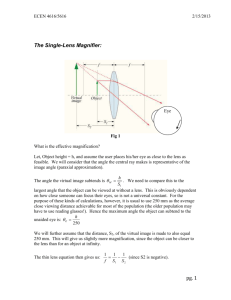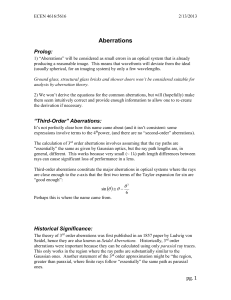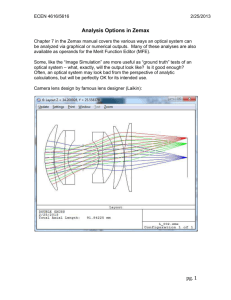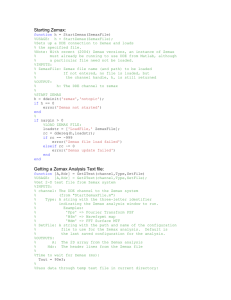05a) Pupils and Stops_1_25
advertisement
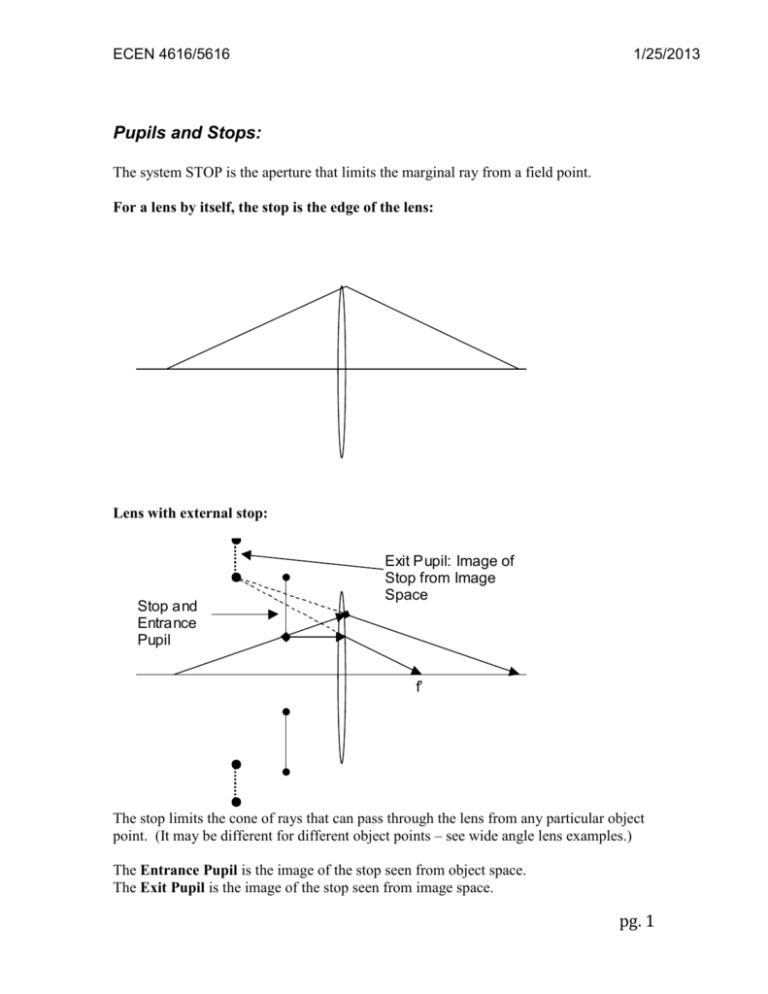
ECEN 4616/5616 1/25/2013 Pupils and Stops: The system STOP is the aperture that limits the marginal ray from a field point. For a lens by itself, the stop is the edge of the lens: Lens with external stop: Stop and Entrance Pupil Exit Pupil: Image of Stop from Image Space f’ The stop limits the cone of rays that can pass through the lens from any particular object point. (It may be different for different object points – see wide angle lens examples.) The Entrance Pupil is the image of the stop seen from object space. The Exit Pupil is the image of the stop seen from image space. pg. 1 ECEN 4616/5616 1/25/2013 Pupils and Ray Tracing: 1. There is no point in tracing a ray that misses the stop, as it will not traverse the system and contribute to the image. 2. If the stop is behind the lens (or some lenses, in a compound system), then rays can be aimed into the entrance pupil, which is the image of the stop as seen from object space. Because of the properties of imaging, a ray aimed into the entrance pupil is guaranteed to make it through the stop. Zemax (and most other programs’) conventions: Many analyses in Zemax will require you to specify both the Field and Pupil coordinates of a ray. These are normalized coordinates that go from –1 to 1 in X and Y and have the following meaning: I) II) The field dialog box (you will use in the tutorial) lets you specify points on the object by a number of measures: angle, object height, etc. The normalized field coordinates (labeled Hx, Hy in Zemax) go from zero at the Z-axis to 1.0 at the maximum size specified in the dialog box, in either X or Y – normalized coordinates are always symmetrical, then don’t have different scales in X and Y. The pupil coordinates (labeled Px, Py in Zemax) refer to the X,Y location in the entrance pupil (and hence, in the stop and exit pupil as well) in the same way: Px=Py=0 is the center of the pupil, and Px=1,Py=0 is the top edge of the pupil. (NOTE, that Px=1, Py=1, would fall outside of a circular pupil.) Zemax does the work of figuring out where the appropriate pupil is, and which way the ray should be aimed to get from the designated field position to the desired pupil position. This is usually very convenient. Caveats about Zemax (and most other programs, as well): I) II) In sequential mode (which is all our version allows) Zemax traces rays from surface to surface in the order that they are in the Lens Design Editor. If any of the distances in that editor are negative, then this won’t be the order that the surfaces are placed in space. This leads to non-physical behavior. Zemax does not check for this problem – that is up to you. You can simulate this by deciding to trace rays through a system in a different order than the elements make from left to right. The equations all still work (if you follow the sign convention), but the results are nonsense. Not all analysis methods are meaningful for all systems. Zemax sometimes will warn you of this. pg. 2 ECEN 4616/5616 1/25/2013 Aberrations: Aberrations are errors in the imaging task – rays that start from the same object point do not all arrive at the associated image point. We will be covering Aberration Theory later in the course, but will deal with specific aberrations on a necessary basis. Some aberrations arise in the paraxial domain: “Chromatic Focal Shift” is an example. It is simply the change in focal length with wavelength due to materials having different indices of refraction for different wavelengths. As a paraxial aberration, it can be corrected paraxially, which we will do in the next several weeks as a prelude to designing achromatic lenses – lenses that have minimal chromatic focal shift. Some aberrations of finite-size optics only show up at off-axis fields, some everywhere. An aberration we will be using Zemax to minimize in the next homework is called “Spherical Aberration”, which is illustrated in the following drawings. Spherical aberrations arises for two reasons: I) The surface of a sphere diverges from the quadratic (that 1st order optics is based on) as the radial distance from the Z-axis increases. Ultimately, a sphere is limited by it’s Radius of Curvature and rays further than that from the axis will miss it altogether. Long before that happens, however, the angle of incidence of the ray with the surface is increasing significantly faster with ray height than for the paraxial approximation. II) In addition, Snell’s law using sine functions is also increasingly non-linear as the angle of incidence increases. Spherical Aberration: Lens power changes with ray height Positive SA: lens power increases with height pg. 3 ECEN 4616/5616 1/25/2013 SA is the consequence of the deviation of sin(x) from x outside the paraxial region: pg. 4 ECEN 4616/5616 1/25/2013 Example of Spherical Aberration (SA): (‘TA’ stands for ‘Transverse Aberration’ – the distance a ray misses the paraxial focal point on the focal plane.) Why does reversing the lens above greatly reduce SA? (Answer: The maximum angle of incidence is much less when both surfaces participate in refraction.) pg. 5 ECEN 4616/5616 1/25/2013 How to do Fourier Optics in a Ray Trace Program? Given an optical system that is analyzed by tracing rays: Zemax (and other programs) will give us wave-based data such as: Wavefront Maps: pg. 6 ECEN 4616/5616 1/25/2013 MTF Plots: Diffraction PSF: pg. 7 ECEN 4616/5616 1/25/2013 Wave-based Analyses are calculated from the pupil OPD. To construct a Optical Path Difference map of the exit pupil, first a ray is traced from the desired object point through the center of the entrance pupil (and, hence out the center of the exit pupil). This is called the chief ray. Then, rays are traced from the same object point through various parts of the entrance pupil (and hence exit pupil). When the rays arrive at the image plane, the OPD between each ray and the chief ray is recorded. This set of OPD values is then assigned to the exit pupil. A perfect optical system will have the OPD values at the exit pupil describe a spherical wavefront centered on the image point. The differences between the actual OPD values and the ideal sphere are what Zemax displays at the “Wavefront Map”. From this relative (to a sphere) wavefront pupil map, the various wave-based analysis properties can be calculated as follows: (Question: What is the geometrical meaning – i.e., in rays -- of these relationships?) psf FP 2 OTF Fpsf F FP 2 F FP FP P P (autocorre lation the orem) and MTF OTF What approximations are involved in this method, and when do they hold? All diffraction is ignored up to the exit pupil. This approximation assumes that only a trivial amount of the total light energy is scattered by diffracting from the edges of lenses, stops and diffraction spreading while propagating through the optical system. Only the diffraction effects where the light is concentrated in a small area (such as the PSF) are considered. This is a good approximation, as long as all of the structures in the optical system are much larger than a wavelength of light. When lenses get to be only a few dozen (or less) wavelengths across, such as pixel lenslets for detector arrays, the light diffracted by individual elements in the optical pg. 8 ECEN 4616/5616 1/25/2013 system will become a significant fraction of the total light and this approximation breaks down. In these cases, the light propagation through the optical system must be modeled using wave propagation algorithms. Obviously, if dedicated diffractive structures -- such as gratings -- exist in the optical system, they have to be explicitly accounted for, although it may be possible to use ray splitting to model the grating if the grating is large w.r.t. the wavelength and still only consider diffraction from the exit pupil to the image. pg. 9



